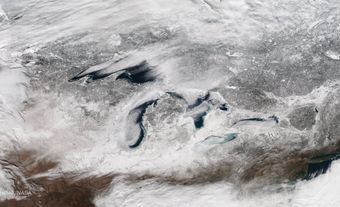Lake of the Woods, 4350 km2 (of which 3149 km2 are in Canada), elevation 323 m, fed by Rainy River from the south and drained to the northwest by the Winnipeg River; it is a remnant of former glacial Lake Agassiz. The south shore is regular, low and sandy, contrasting with the granite edge, myriad channels, peninsulas and 14 632 islands of the north shore. Thrust into the lake from the east is Aulneau Peninsula, named for the Jesuit priest Jean-Pierre Aulneau (1705-36) who, along with Jean-Baptiste La Vérendrye and 19 others, was killed on an island in the lake by Sioux warriors. The French explorer Jacques de Noyon reached the lake in 1688, and La Vérendrye built Fort Saint-Charles on the north shore (1732).
The lake was part of the main fur-trade route, and voyageurs frequently lost their way among its islands. Cree, Ojibwa and Sioux lived in the area first, and rock paintings have been found at several sites. About 2000 native people still live around the lake in numerous reserves. The Canada-US border runs north-northwest from the mouth of Rainy River across the lake, leaving a small peninsula of US territory above the 49th parallel.
The scenic lake attracts a thriving tourist trade. In early August, sailboats from Canada, Britain and the US take part in the Lake of the Woods Regatta, a 7-day race from Kenora around the lake. The lake's islands are wooded, but the name is likely a mistranslation of an Indigenous word meaning "inland lake of the hills."

 Share on Facebook
Share on Facebook Share on X
Share on X Share by Email
Share by Email Share on Google Classroom
Share on Google Classroom

